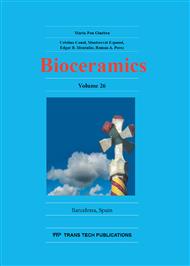[1]
Daculsi, G., et al., Current state of the art of biphasic calcium phosphate bioceramics, J. Mater. Sci. - Mater. Med. 14 (2003) 195-200.
Google Scholar
[2]
Thürmer, M.B., et al. Synthesis of Alpha-Tricalcium Phosphate by Wet Reaction and Evaluation of Mechanical Properties. Mater. Sci. Forum. 727 (2012) 1164-1169.
DOI: 10.4028/www.scientific.net/msf.727-728.1164
Google Scholar
[3]
Rohanizadeh , R., et al. Ultrastructural study of apatite precipitation in implanted calcium phosphate ceramic: Influence of the implantation site. Calcif. Tissue Int. 64 (1999) 430-436.
DOI: 10.1007/pl00005825
Google Scholar
[4]
Dorozhkina, E.I. and S.V. Dorozhkin, Mechanism of the solid-state transformation of a calcium-deficient hydroxyapatite (CDHA) into biphasic calcium phosphate (BCP) at elevated temperatures, Chem. Mater. 14 (2002) 4267-4272.
DOI: 10.1021/cm0203060
Google Scholar
[5]
Liou, S. -C. and S. -Y. Chen, Transformation mechanism of different chemically precipitated apatitic precursors into β-tricalcium phosphate upon calcination, Biomaterials. 23 (2002) 4541-4547.
DOI: 10.1016/s0142-9612(02)00198-9
Google Scholar
[6]
6 Daculsi G., et al, Lattice defects in calcium phosphate ceramics: High resolution TEM ultrastructural study. J. Biomed. Mat. Res. App. Biomat. 2 (1991)147-152.
DOI: 10.1002/jab.770020302
Google Scholar
[7]
Rodriguez-Carvajal J., Roisnel T., FullProf. 98 and WinPLOTR: New Windows 95/NT Applications for Diffraction. Commission For Powder Diffraction, International Union for Crystallography, Newsletter 20 (1998) 35.
Google Scholar
[8]
Obadia, L., et al., Effect of sodium doping in β-tricalcium phosphate on its structure and properties, Chem. Mater. 18 (2006) 1425-1433.
Google Scholar
[9]
Kannan, S., et al., Ionic Substitutions in Biphasic Hydroxyapatite and β‐Tricalcium Phosphate Mixtures: Structural Analysis by Rietveld Refinement, J. Am. Ceram. Soc. 91 (2008) 1-12.
DOI: 10.1111/j.1551-2916.2007.02117.x
Google Scholar
[10]
Miramond, T., et al., Osteopromotion of Biphasic Calcium Phosphate granules in critical size defects after osteonecrosis induced by focal heating insults, IRBM. 34(2013) 337-341.
DOI: 10.1016/j.irbm.2013.07.004
Google Scholar
[11]
Miramond, T., et al., Osteoinduction of biphasic calcium phosphate scaffolds in a nude mouse model, J. Biomater. Appl. (2014) doi: 10. 1177/0885328214537859.
DOI: 10.1177/0885328214537859
Google Scholar
[12]
Daculsi G., et al, Formation of carbonate apatite crystals after implantation of calcium phosphate ceramics. Calcif. Tissue Int. 46 (1990) 20-27.
DOI: 10.1007/bf02555820
Google Scholar
[13]
Daculsi G, et al, Association cellules-matériaux pour Thérapies cellulaires Osseuses. IRBM 32 (2011) 76-79.
DOI: 10.1016/j.irbm.2011.01.031
Google Scholar


